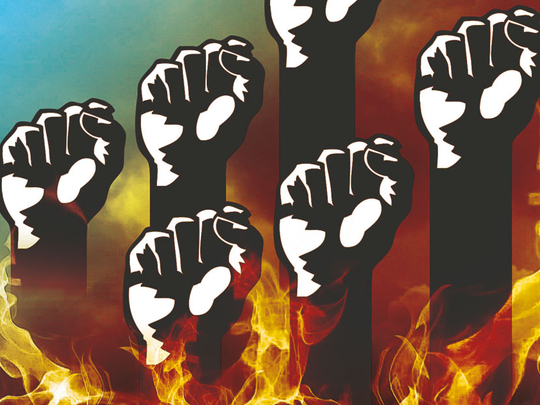
You can bet your bottom dollar that many people, politicians and even governments in the region and internationally are gloating at the popular protests taking place in Iran. Privately, they might be saying “serves them right”, in reference to the Iranian government, which is facing what might be termed as a “late Arab Spring” crisis, not on its doorstep, as the case in the past, but in the very heart of Persia.
The present vaunt could at least be explained by the fact that the government in Iran, at least since the Arab Spring eruptions of 2011 onwards, has been meddling in the internal affairs of different states of the region and has been itself regularly boasting about that fact with no qualm or compunction. Today, with its own popular protests, the tables are clearly being turned.
The Iranian leadership has clearly been myopic in its conceptualisation of the region, of Lebanon, Syria, Iraq, Yemen and even Saudi Arabia and Bahrain. It has clearly been short-sighted while attempting to increase its influence in its backyard, through financial “prop ups” and building regional proxies with states and non-state actors like Hezbollah, Al Houthis and different Shiite factions in Iraq. But it seems to be paying up time! The Iranian government might now have to clearly forfeit its past deeds and regional expanse, gravely and starkly, displayed in Syria where Iran has poured money, manpower and intelligence to prop up the teetering Baath regime.
With the benefit of hindsight, this is clearly proving to be the straw that is breaking the camel’s back for the Iranians are now saying instead of squandering its money on tenuous regional influence, the government should have been improving the lot of its own, people in dire straits with soaring inflation, 50 per cent of the population above the poverty line, with one out of every eight workers out of job and youth unemployment at 40 per cent. This is clearly a powder-keg and one wonder’s why it took so long for the Iranian people to rise in protest, bearing in mind that the last mass demonstrations had occurred in 2009, before being crushed by the government.
But judging from the past two weeks’ developments, this is proving to be no more. Dare one speak of a “late Arab Spring” being triggered in Iran to the detriment and dismay of the government. Like its counterparts in different Arab countries six or seven years earlier, the Iranian government has clearly been surprised by the protests that first sparked in Mashhad, in the northern part the country, before spreading to the rest of Iran. It looked like as if 70-odd cities and towns were rising up in protest, all at once, or following a domino-effect. After Mashhad, protests were registered in Qom, the country’s religious capital, Tehran, Shiraz, Kermanshah, Khorramabad, Shahr-e-Kord, Bandar Abbas, Izeh, Arak, Zanjan, Abhar, Doroud, Khorramabad, Ahvaz, Karaj, Tonekabon, Shahinshahr and Zanjan. In just one week, since the last week of December 2017, the protests have travelled from the north of the country, to the east, centre, south and west, with people demanding a change in the standard of their livelihood.
The government, subdued until now, should actually display greater worry today since some of the protests are also occurring in its clerical strongholds such as Sari, Hamedan and Qazvin that are also places of religious influence and where people had given a carte-blanche support to the theocratic regime.
This is not a middle-class movement as was the case in 2009 when young, urban and educated Iranians demonstrated under the Green Revolution — following the disputed election of president Mahmoud Ahmadinejad — and demanded free and fair elections. This time around, frustration has spread to different corners of the country. Rising discontent has spread to the working class, the rural poor as well as traditional supporters of the regime. They are venting their frustrations on the streets because of economic woes, failed government policies, rising prices — including that of gasoline — as well as removal of subsidies, corruption, mismanagement and nepotism that are rife in Iranian administration. Similar sentiments had fuelled the protests in the Arab Spring countries earlier.
The current unrest in Iran will surely prove to be a great source of worry because as long as you don’t plug in the holes in the economy and find potent answers to woes, this sense of disenchantment will only mount further among all classes of Iranian society. Already deaths have occurred and thousands have been arrested, with the numbers likely to spiral up. This is why the government needs to move quickly and alleviate the situation through pumping in more money in the economy.
The anger up till now has been simmering since many people have already realised that the government coffers are full as a result of the $100 billion (Dh367.8 billion) in frozen assets that have been released as part of the 2015 nuclear deal that Tehran had signed with the United States, Britain, France, Russia, China and Germany. Poor and dejected people are livid that a sizeable chunk of these assets are going to states like Syria and outfits like Hezbollah and Al Houthis.
The old slogans seeking “regime change” and throwing the old order out, that were heard across various Arab capitals during the Arab Spring unrest, are today being heard in different parts of Iran — even in remote areas that were never before known to have undertaken any public display of discontent. So, it is clearly time for the Iranian regime to take stock of the current scenario and react accordingly. It is no good blaming the current protests on the outside world. These are fundamentally Iran’s domestic issues and beating around the bush will only make matters worse.
Marwan Asmar is a commentator based in Amman. He has long worked in journalism and has a PhD in Political Science from Leeds University in the UK.









